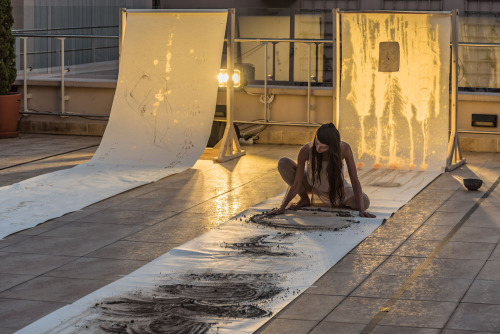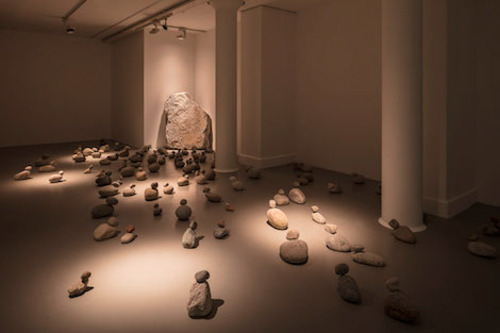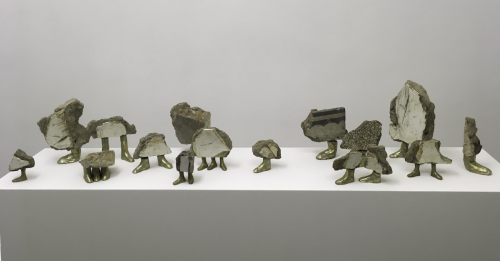
Before starting my residency at ANAMED, I was very much looking forward to dive into Istanbul’s art scene, which I had imagined as a vibrant constellation brimming with art galleries, museums and exhibitions.
My expectations were not disappointed, as the city’s cultural life is currently further enriched by the events happening under the umbrella of the 15th Istanbul Biennale. Something I had not foreseen, however, is the presence of a distinctly archaeological sensibility in the works of so many Istanbul-based artists. In hindsight, this should not be so surprising for a city whose complicated identity resides widely in the stratification of people, things and stories that have inhabited the shores of the Bosphorus throughout Istanbul’s long history.
In this short article, which is not or tries to be comprehensive, I will briefly discuss a handful of works that I have encountered in the last few weeks and found particularly interesting and thought-provoking, especially from an archaeological perspective. These works all happen to belong to young and talented female artists: Burçak Bingöl, Canan Budak, Nazlı Gürlek, CANAN, and Hera Büyüktaşçıyan. In their works, archaeological remains are not simply the materialization of the city’s far-reaching memory, but also sites of contention and multiple interpretations. For some of these artists, archaeological remains are also starting points for obdurate endeavors of interpersonal connection, not only with the people living in the past but also between humans and other forms of life.
1. Burçak Bingöl, Falling into II, 2017, Anna Laudel Contemporary
As one of the artists featured in the group exhibition “Past meets Present” at Anna Laudel Contemporary in Galata, Burçak Bingöl plays with one of the cornerstones of archaeological imagination: the potsherd. Breaking the usual distinction between form and decoration, she boldly presents a vase in fragments where the only decoration – a colorful Ottoman-style floral design – lies in the cracks, while the surface of the vase is simply glazed white. In this way, the fragments reveal something that the vase in its entirety would have concealed. Winking at the Japanese aesthetics of wabi-sabi, this work is an ode to the beauty of things imperfect and incomplete, as most of archaeological things are.

Burçak Bingöl, Falling into II, 2017
2. Canan Budak, “Kırmızı,”2016
Presented in Diyarbakır in 2016, Canan Budak’s video performance “Kırmızı” reflects on archaeological imagination and on the interplay between presence and absence in the construction of the archaeological past. Under the eye of a drone overlooking an excavation trench, a number of red blocks are moved from a location to another, creating new architectural features that stand out among the other archaeological remains due to their bright colour. The newly created entity is thus abstract and yet inherently material; it might be pointing to something that used to be there as well as being something entirely invented. In this way, Canan Budak makes several points about the performative construction of collective memory, which is also strongly connected to the ways place is created through the construction of material and immaterial boundaries. https://safe.txmblr.com/svc/embed/inline/https%3A%2F%2Fwww.youtube.com%2Fwatch%3Fv%3DMmCrmLEsdos%26feature%3Dyoutu.be#embed-65b00abdb11c1556473817-partied
3. Nazlı Gürlek, “ONE,”2017
I could not fail to mention Nazlı Gürlek’s performance piece “ONE,” both because it was staged here at ANAMED on September 23th 2017 on the occasion of the exhibition “The Curious Case of Çatalhöyük” and because it deals with the core of my own doctoral research, i.e. the architectural paintings from Çatalhöyük. Fittingly enough, the first time I met Nazlı at Çatalhöyük in 2016, it was right in front of the very same painting that provided the inspiration for “ONE.” When we met again this September during one of the rehearsals of “ONE,” she told me that she felt immediately drawn to the fluid geometric patterns of the Neolithic painting, although she also felt a sense of frustration due to our very limited understanding of its meaning and original context. This sense of frustration, however, was not an end point; it rather was the beginning of an obdurate desire for connection and understanding that the performance expresses in all its urgency, a desire to be “ONE” with the past that is not discursive but rather emotional, almost visceral, and firmly grounded in the human body.
Starting from the archaeological understanding that the painting was created as part of a ritual, Gürlek creates a contemporary ritual bringing together multiple ways of expression including painting, sound, documentation and movement. In the course of the 3-hour performance, two 9-metre rolls of paper with drawings inspired by the Çatalhöyük painting are gradually unfolded by the performer (a deeply empathic Aslı Bostancı), while images of the Neolithic painting are projected onto a low wall. In one of the most intense moments of the entire performance, Bostancı spreads soil on one of the paintings, creating ephemeral forms that are superimposed on Gürlek’s drawings and ideally also on the Neolithic painting. This multi-layered effect well corresponds to the nature of Çatalhöyük paintings as ever-changing palimpsests of superimposed painted layers.

Performer Aslı Bostancı during one moment of Nazlı Gürlek’s “ONE.” Photo Photo by: Jason Quinlan.
4. CANAN, “Bird Woman,” 2017, ARTER
As part of her solo exhibition “Behind Mount Qaf,” currently on display at ARTER, CANAN presents one of her recent works, entitled “Bird Woman” (2017). Inspired by her visit to the 11,000 years old site of Göbekli Tepe near Urfa, CANAN reinvents the engraving of a female body on a stone slab from the site by depicting her in a state of metamorphosis into bird. The engraved stone slab is surrounded by a group of stylized birds made of found stones. The artist explicitly links the work to a Persian legend recounting the journey of 30 birds to Mount Qaf in search of salvation, but the work can also be read in the light of an animistic worldview based on the commonality and permeability of human, animal and material forms, which are all always – just like the birds and the bird woman in the installation – on the verge of turning into something else. This relational and dynamic worldview characterizes many contemporary indigenous societies and may also be reflected in the highly dynamic portrayals of animals and humans in the steles of Aceramic Neolithic Göbekli Tepe.
CANAN’s exhibition “Behind Mount Qaf” will be on display at ARTER until December 24th, 2017.

CANAN, “Bird Woman,” 2017. Photo by Murat Germen
5. Hera Büyüktaşçıyan, “Archipelagos / Archipelago,” 2017, Daire Sanat
Hera Büyüktaşçıyan’s work “Archipelagos / Archipelago” is a site-specific installation for the exhibition “Floating Tactics After a Sunken Island,” currently on display at Daire Sanat in Cihangir. Engaging with the theme of the exhibition, Büyüktaşçıyan explores the intersections between sense of place and the mobility of people and things. Attaching human-like feet to found pieces of concrete and marble, she seems to wonder: what if, just like the many people who arrived and left the shores of the Bosphorus throughout Istanbul’s history, the things left behind could move too? Where would they go – perhaps stumbling a bit, especially those with one or three feet – if they really had a chance to leave? “Archipelagos / Archipelago”is only the last example of a number of works where Büyüktaşçıyan engages with the material remains of the past in an effort to bring back the erased or forgotten stories of previous inhabitants. Extensive historical and archaeological research is also an important component of Büyüktaşçıyan’s art practice.
The group exhibition “Floating Tactics After a Sunken Island,”featuring Hera Büyüktaşçıyan and other artists, will be on display at Daire Sanat until November 11th, 2017.

Hera Büyüktaşçıyan, “Archipelagos / Archipelago,” 2017

